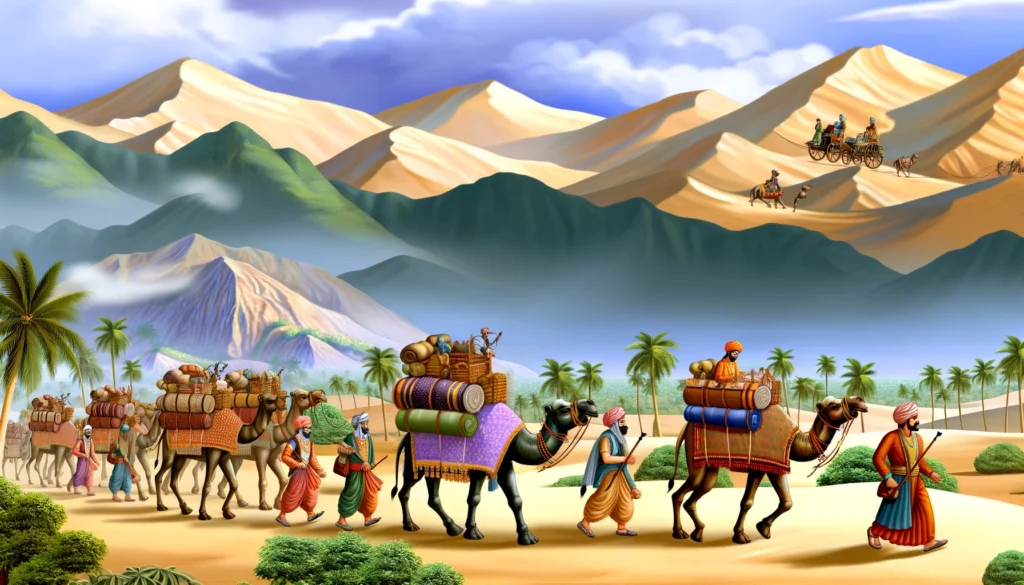Welcome back to “India’s Economic Odyssey: Past to Present.” In our second installment, we journey through the Mughal Era, a period that not only defined India’s cultural landscape but also marked a significant chapter in its economic history. This era of prosperity under the Mughals brought about remarkable advancements in agriculture, trade, and manufacturing, showcasing a blend of innovative governance and economic strategies.
Agricultural Revolution under the Mughals
The Mughal era, spanning from the early 16th century to the mid-18th century, was not just a period of immense cultural and architectural achievements but also a time of significant agricultural transformation. The backbone of the Mughal economy was its agriculture, which supported the vast majority of its population. The Mughals introduced several innovative agricultural practices and policies that profoundly impacted the agrarian landscape of India.

One of the most notable contributions was the “Zabt” system, introduced during Akbar’s reign. This system involved a meticulous survey and classification of agricultural land, with the aim of assessing land productivity to levy taxes accordingly. Such a methodical approach ensured a consistent and fair revenue stream for the empire, encouraging farmers to cultivate their land efficiently and expand agricultural production.
Moreover, the Mughals’ emphasis on cash crops like cotton, indigo, and sugarcane diversified India’s agricultural output, boosting the empire’s economic prosperity. The introduction of new crops and the development of irrigation systems, including canals and wells, further enhanced agricultural productivity, ensuring food security and surplus for trade.
Flourishing Trade and Commerce
Under the Mughals, India’s trade and commerce flourished like never before. The empire’s strategic geographical position, bridging the East and the West, played a pivotal role in establishing it as a hub of global trade. The Mughals fostered an environment conducive to trade by investing in infrastructure, such as roads and ports, which facilitated the smooth flow of goods within the empire and beyond its borders.

Notable ports like Surat on the west coast and Chittagong on the east became bustling centers of international trade. These ports welcomed merchants from across the world, dealing in a wide array of goods. India exported its famed textiles, spices, and precious stones, receiving in return gold, silver, and luxury items from Europe and the Middle East. The liberal trade policies of the Mughals, coupled with their diplomatic relations with other countries, significantly boosted India’s export economy.
The era also saw the rise of merchant guilds, which played a crucial role in managing trade routes and ensuring the welfare of their members. These guilds, akin to modern-day corporations, facilitated the expansion of trade networks, reaching as far as Africa, the Middle East, and Southeast Asia.
The Artisanal Boom
The Mughal period heralded a golden age for India’s artisanal industry. The empire’s artisans were renowned for their exquisite craftsmanship, particularly in textiles, metalwork, and jewelry. The demand for these artisanal goods was not limited to the domestic market but extended across the globe, contributing significantly to the empire’s wealth.

The Mughals were great patrons of the arts, and this patronage extended to the support of artisans and craftsmen. Artisanal workshops flourished under the Mughal rule, with cities like Agra, Delhi, and Lahore becoming centers of artisanal production. The guilds that organized these artisans ensured quality control, regulated prices, and managed the training of apprentices, thereby maintaining high standards of craftsmanship.
The artisanal boom of the Mughal era was a key contributor to the urbanization and economic development of the period. The exquisite Mughal carpets, textiles, and jewelry continue to be celebrated worldwide for their beauty and intricate craftsmanship, serving as a testament to the vibrant artisanal culture of the time.
Through these endeavors in agriculture, trade, and artisanal production, the Mughal era significantly shaped the economic landscape of India, laying the groundwork for future developments and establishing a legacy of prosperity and innovation.
Author’s Note
As we wrap up our exploration of the Mughal Era, it’s clear that this period was a cornerstone in shaping India’s economic history. The Mughals’ innovative policies in agriculture, trade, and artisanal production not only propelled the empire to great heights of prosperity but also laid foundational economic practices that influenced future generations.
G.C., Ecosociosphere contributor.
References and Further Reading
- “The Empire of the Great Mughals: History, Art and Culture” by Annemarie Schimmel provides insights into the cultural and economic achievements of the Mughal Empire.
- “The Economy Of The Mughal Empire c. 1595 – A Statistical Study” by Shireen Moosvi offers an in-depth analysis of the economic strategies and outcomes of Mughal governance.
Join us in our next post, where we’ll delve into the transformative period of colonial rule and its lasting impact on India’s economy. Stay tuned to continue the journey through India’s economic odyssey.





Comments
Thanks for sharing. I read many of your blog posts, cool, your blog is very good.
Your article helped me a lot, is there any more related content? Thanks!
Your point of view caught my eye and was very interesting. Thanks. I have a question for you.
Your article helped me a lot, is there any more related content? Thanks!
Can you be more specific about the content of your article? After reading it, I still have some doubts. Hope you can help me.
Can you be more specific about the content of your article? After reading it, I still have some doubts. Hope you can help me.
Thank you for your sharing. I am worried that I lack creative ideas. It is your article that makes me full of hope. Thank you. But, I have a question, can you help me? https://accounts.binance.info/en/register-person?ref=JHQQKNKN
Your article helped me a lot, is there any more related content? Thanks!